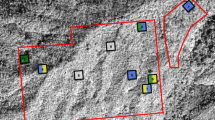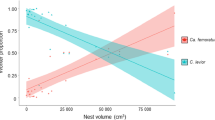The ponerine ant Pachycondyla goeldii is a monogynous (i.e. one queen per colony) arboreal species that colonizes pioneer areas. Founding queens and first generation workers initiate their own ant garden by building a cardboard-like structure into which epiphyte seeds are integrated. Following the growth of the epiphyte, the colony establishes its nest within the root system. This particular nest-building behavior is crucial in an environment where suitable nest sites are rare. Nevertheless, the slow growing process of ant gardens does not allow this species to readily evacuate and find another refuge in the advent of an attack by a predator or worsening climatic conditions. Previous field studies of P. goeldii were performed after forest destruction and subsequent colonization by P. goeldii. As a result, the colonies studied where relatively young and monodomous (i.e. one nest per colony). Our study of nest composition, worker exchanges between ant gardens in the field, and dyadic encounters shows that mature colonies of P. goeldii are polydomous (i.e. multiple nests per colony). In ants, the association of polydomy with monogyny has infrequently been reported. To our knowledge, P. goeldii represents the first record of a Ponerinae exhibiting both these particular characteristics. Our field and laboratory experiments suggest that polydomy is adaptively advantageous in coping with the microclimatic instability of pioneer areas by providing colonies with easily accessible nests.



Similar content being viewed by others
REFERENCES
Banschbach, V. S., Levit, N., and Herbers, J. M. (1997). Nest temperatures and thermal preferences of a forest ant species: Is seasonal polydomy a thermoregulatory mechanism? Insectes Soc. 44: 109–122.
Beugnon, G., Chagné, P., and Dejean, A. (2001). Colony structure and foraging behavior in the tropical formicine ant, Gigantiops destructor. Insectes Soc. 48: 347–351.
Bolton, B. (2003). Synopsis and classification of Formicidae. Mem. Am. Entomol. Inst. 71: 1–370.
Brian, M. V. (1956). Segregation of species of the ant genus Myrmica. J. Anim. Ecol. 25: 319–337.
Carlson, D. M., and Gentry, J. B. (1973). Effects of shading on the migratory behavior of the Florida harvester ant, Pogonomyrmex badius. Ecology 54: 452–453.
Cerdá, X., and Retana, J. (1998). Interference interactions and nest usurpation between two subordinate ant species. Oecologia 113: 577–583.
Cerdá, X., Dahbi, A., and Retana, J. (2002). Spatial patterns, temporal variability, and the role of multi-nest colonies in a monogynous Spanish desert ant. Ecol. Entomol. 27: 7–15.
Chapuisat, M., Goudet, J., and Keller, L. (1997). Microsatellites reveal high population viscosity and limited dispersal in the ant Formica paralugubris. Evolution 51: 475–482.
Corbara, B., and Dejean, A. (1996). Arboreal nest building and ant-garden initiation by a ponerine ant. Naturwissenschaften 83: 227–230.
Curtis, B. A. (1985). Nests of the Namib Desert dune ant Camponotus detritus Emery. Insectes Soc. 32: 313–320.
Davidson, D. W. (1997). The role of resource imbalances in the evolutionary ecology of tropical arboreal ants. Biol. J. Linn. Soc. 61: 153–181.
Dejean, A., Corbara, B., Snelling, R. R., and Belin, M. (1997). Les jardins de fourmis de Guyane francaise: Relations entre arbres-support, épiphytes et fourmis. Acta Bot. Gallica 144: 333–345.
Dejean, A., Corbara, B., Orivel, J., Snelling, R. R., Delabie, J. H. C., and Belin-Depoux, M. (2000). The importance of ant gardens in the pioneer vegetal formations of French Guiana (Hymenoptera: Formicidae). Sociobiology 35: 425–439.
Debout, G., Provost, E., Renucci, M., Tirard, A., Schatz, B., and McKey, D. (2003). Colony structure in a plant-ant: Behavioural, chemical and genetic study of polydomy in Cataulacus mckeyi (Myrmicinae). Oecologia 137: 195–204.
Delabie, J. H. C., Benton, F. P., and Medeiros, M. A. D. (1991). La polydomie chez les Formicidae arboricoles dans les cacaoyères du Brésil: Optimisation de l’occupation de l’espace ou stratégie défensive? Actes Coll. Insects Soc. 7: 173–178.
Droual, R. (1984). Anti-predator behavior in the ant Pheidole desertorum: The importance of multiple nests. Anim. Behav. 32: 1054–1058.
Foitzik, S., and Heinze, J. (1998). Nestsite limitation and colony take over in the ant, Leptothorax nylanderi. Behav. Ecol. 9: 367–375.
Foitzik, S., and Herbers, J. M. (2001). Colony structure of a slavemaking ant. I. Intracolony relatedness, worker reproduction, and polydomy. Evolution 55: 307–315.
Foitzik, S., Heinze, J., Oberstadt, B., and Herbers, J. M. (2002). Mate guarding and alternative reproductive tactics in the ant Hypoponera opacior. Anim. Behav. 63: 597–604.
Federle, W., Maschwitz, U., and Fiala, B. (1998). The two-partner ant-plant system of Camponotus (Colobopsis) sp. 1 and Macaranga puncticulata (Euphorbiaceae): Natural history of the exceptional ant partner. Insectes Soc. 45: 1–16.
Hasegawa, E. (1992). Annual life cycle and timing of male egg production in the ant Colobopsis nipponicus (Wheeler). Insectes Soc. 39: 439–446.
Herbers, J. M., DeHeer, C. J., and Foitzik, S. (2001). Conflict over sex allocation drives conflict over reproductive allocation in perennial social insect colonies. Am. Nat. 158: 178–192.
Hölldobler, B., and Lumsden, C. J. (1980). Territorial strategies in ants. Science 210: 732–739.
Hölldobler, B., and Wilson, E. O. (1990). The ants. Harvard University Press, Cambridge, Mass.
Holway, D., and Case, T. (2000). Mechanisms of dispersed central-place foraging in polydomous colonies of the Argentine ant. Anim. Behav. 59: 433–441.
Ito, F., Higashi, S., and Maeta, Y. (1988). Growth and development of Camponotus (Paramyrmamblys) kiusiuensis Santschi colonies (Hymenoptera Formicidae). Insectes Soc. 35: 251–261.
Mabelis, A. A. (1979). Nest splitting by the red wood ant (Formica polyctena Foerster). Neth. J. Zool. 29: 109–125.
Mercier, J. L. (1999). Territorialité et agressivité intra- et interspécifique dans les mosaïques de fourmis arboricoles. Année Biologique 38: 149–168.
McGlynn, T. P., Carr, R. A., Carson, J. H., and Buma, J. (2004). Frequent nest relocation in the ant Aphaenogaster araneoides: Resources, competition, and natural enemies. Oikos 106: 611–621.
McIver, J. D. (1991). Dispersed central place foraging in Australian meat ants. Insectes Soc. 38: 129–137.
Orivel, J. (2000). L’adaptation à la vie arboricole de la fourmi Pachycondyla goeldii (Hymenoptera: Ponerinae). PhD thesis, Université Paris XIII, Villetaneuse, 225 p.
Orivel, J., and Dejean, A. (1999). Selection of epiphyte seeds by ant garden ants. Ecoscience 6: 51–55.
Orivel, J., Dejean, A., and Errard, C. (1998). Active role of two ponerine ants in the elaboration of ant gardens. Biotropica 30: 487–491.
Orivel, J., Souchal, A., Cerdan, P., and Dejean, A. (2000). Prey capture behavior of the arboreal ponerine ant Pachycondyla goeldii (Hymenoptera: Formicidae). Sociobiology 35: 131–140.
Orivel, J., Malherbe, M. C., and Dejean, A. (2001). Relationships between pretarsus morphology and arboreal life in ponerine ants of the genus Pachycondyla (Formicidae: Ponerinae). Ann. Entomol. Soc. Am. 94: 449–456.
Peeters, C., and Crewe, R. M. (1985). Worker reproduction in the ponerine ant Ophthalmopone berthoudi: An alternative form of eusocial organization. Behav. Ecol. Sociobiol. 18: 29–37.
Pezon, A., Denis, D., Cerdan, P., Valenzuela, J., and Fresneau, D. (2005). Queen movement during colony emigration in the facultatively polygynous ant Pachycondyla obscuricornis. Naturwissenschaften 92: 35–39.
Pfeiffer, M., and Linsenmair, K. E. (1998). Polydomy and the organization of foraging in a colony of the Malaysian giant ant Camponotus gigas (Hym./Form.). Oecologia 117: 579–590.
Rosengren, R., Sundström, L., and Fortelius, W. (1993). Monogyny and polygyny in Formica ants: The results of alternative dispersal tactics. In Keller, L. (ed.), Queen number and sociality in insects, Oxford University Press, Oxford, pp. 308–333, 439 p.
Smallwood, J. (1982). Nest relocation in ants. Insectes Soc. 29: 138–147.
Snyder, L. E., and Herbers, J. M. (1991). Polydomy and sexual allocation ratios in the ant Myrmica punctiventris. Behav. Ecol. Sociobiol. 28: 409–415.
Traniello, J. F. A., and Levings, S. C. (1986). Intra- and intercolony patterns of nest dispersion in the ant Lasius neoniger. correlations with territoriality and foraging ecology. Oecologia 69: 413–419.
Verhaagh, M. (1994). Pachycondyla luteola (Hymenoptera, Formicidae), an inhabitant of Cecropia trees in Peru. Andrias 13: 215–224.
Yamaguchi, T. (1992). Interspecific interference for nest sites between Leptothorax congruus and Monomorium intrudens. Insectes Soc. 39: 117–127.
Yamauchi, K., Kimura, Y., Corbara, B., Kinomura, K., and Tsuji, K. (1996). Dimorphic ergatoid males and their reproductive behavior in the ponerine ant Hypoponera bondroiti. Insectes Soc. 43: 119–130.
Yamauchi, K., Oguchi, S., Nakamura, K., Suetake, H., Kawada, N., and Kinomura, K. (2001). Mating behavior of dimorphic reproductives of the ponerine ant, Hypoponera nubatama. Insectes Soc. 48: 83–87.
ACKNOWLEDGMENTS
We are grateful to Dr. P. Cerdan, director of “HYDRECO,” for his logistical help and access to facilities, as well as Kiki for his invaluable help in the field. We wish to thank Dr. A. Pezon for English corrections on the manuscript, and three anonymous referees for helpful comments. DD and DF are grateful to the Laboratoire d’Ethologie Expérimentale et Comparée for funding of the field studies in Petit Saut, French Guiana. The experiments were conducted in accordance with the current laws of France to the best of the authors’ knowledge.
Author information
Authors and Affiliations
Corresponding author
Rights and permissions
About this article
Cite this article
Denis, D., Orivel, J., Hora, R.R. et al. First Record of Polydomy in a Monogynous Ponerine Ant: A Means to Allow Emigration Between Pachycondyla goeldii Nests. J Insect Behav 19, 279–291 (2006). https://doi.org/10.1007/s10905-006-9024-5
Revised:
Accepted:
Published:
Issue Date:
DOI: https://doi.org/10.1007/s10905-006-9024-5




